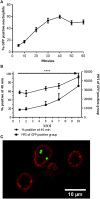Neutrophil Functional Heterogeneity: Identification of Competitive Phagocytosis
- PMID: 29170663
- PMCID: PMC5684128
- DOI: 10.3389/fimmu.2017.01498
Neutrophil Functional Heterogeneity: Identification of Competitive Phagocytosis
Abstract
Introduction: Phagocytosis by neutrophils is a key process in the innate immune response against invading microorganisms. Despite reported heterogeneity in other neutrophils functions, little is known regarding differences in phagocytosis by individual cells. Therefore, we tested the hypothesis that heterogeneity is present in the neutrophil compartment in its potency to phagocytize bacteria.
Methods: Phagocytosis assays were performed in suspension with isolated neutrophils and Staphylococcus aureus expressing different fluorescent proteins at MOIs between 1 and 10. Repetitive addition of bacteria with different fluorescent proteins and MOIs was used to compare the phagocytic capacity of S. aureus-green fluorescent protein (GFP)-positive and negative neutrophils and exclude randomness.
Results: The percentage and mean fluorescence intensity (MFI) of S. aureus-GFP-positive neutrophils increased with higher MOIs. The increase in MFI was due to phagocytosis of multiple bacteria per neutrophil as was confirmed by confocal imaging. Sequential phagocytosis of GFP- and mCherry-expressing S. aureus showed a non-random process, as S. aureus-GFP-positive neutrophils preferentially phagocytized S. aureus-mCherry.
Conclusion: All neutrophils were able to phagocytize S. aureus, but some were much more potent than others. Therefore, at physiologically relevant MOIs these potent phagocytizing neutrophils will outcompete the uptake of bacteria by less competent cells in a process we propose to name "competitive phagocytosis."
Keywords: PMN; Staphylococcus aureus; bacteria; granulocyte; innate immunity.
Figures




References
LinkOut - more resources
Full Text Sources
Other Literature Sources
Miscellaneous

